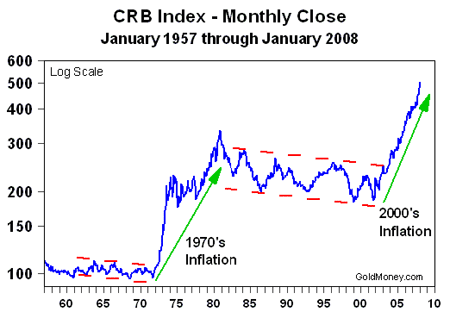
In an alert entitled ‘The Case for Commodities’ that was published on November 9, 2003 I wrote: ‘The flight out of the US dollar continues, and commodities are one of the logical safe havens in the search for undervalued tangible assets. And one of those undervalued tangible assets is gold.’
The CRB Continuing Commodity Index back then had closed at 251.03. Gold closed the same day at $383.30 per ounce ($12.323 per goldgram). The CRB Continuing Commodity Index closed yesterday at a new record high, as we can see from the following chart.
It is clear that the flight out of the dollar continues. But are commodities still a safe haven?
In my view, the answer is a resounding yes. First, commodities are a tangible asset and therefore do not have counterparty risk.
A pound of copper, bushel of wheat or ounce of gold is not dependent upon any bank’s or government’s promise.
The value of a commodity arises from its usefulness, for example, copper in wiring, wheat in bread and gold as money. The absence of counterparty risk makes commodities an increasingly valuable form of wealth today because so many of the promises underlying financial assets are becoming unreliable. But commodities are still a safe haven for another reason.
Despite the big increase in prices in recent years, commodities are still undervalued because much of the price increase results from inflation. I use a number of models to determine relative value, but here’s a simple one.
Let’s start with the November 2003 prices. One ounce of gold could buy the CRB Index 1.5-times ($383.30/251.03). At yesterday’s closing prices, one ounce of gold bought the CRB Index 1.8-times ($922.70/503.27), so clearly relative valuations have changed. But at the January 1980 peak, one ounce of gold bought the CRB Index nearly three times, and we are still far away from that level of relative valuation, which is one signal that gold prices have much further to rise. The following chart is also pointing to that same outcome.
Compare the gold price within the three red ovals. In the early 1970s, when gold started pulling away from the green uptrend line, it continued upward until reaching a level of overvaluation. Gold then retraced, pulling back to the green uptrend line. Gold then repeated this same pattern in the late-1970s.
Now look at the current red oval. Gold is again pulling away from the green uptrend line. We will see in the months ahead whether history will repeat the patterns of the 1970s. I expect it will, just like history seems to be repeating in silver. The parallels between the two pennants in the following silver chart are just too obvious to ignore.
I note above that money is fleeing the US dollar, but the flight into gold is actually from all national currencies. For example, gold is at a record high against the euro.
While on this ‘history does repeat’ theme, it appears to me that 2008 is shaping up much like 1974. There are many similarities. These include rapidly rising inflation and growing monetary problems not only in the States, but across the globe. In fact, the last serious global credit crisis before the present one occurred in 1974.
That was the year when Herstatt Bank failed in what was then West Germany, bringing the international banking system to a near standstill. A couple of months later, Franklin National Bank collapsed in New York, which at that time was the largest bank failure in US history. Slowing economic conditions (then as now) caused loans to go bad, causing losses and erosion of essential capital. Also, lines of credit not previously drawn upon during good times started being used in 1974, with the result that banks became over-leveraged (again, then as now).
Given what happened in 1974, there is one piece of advice that I can recommend. If history is any guide – and I really do believe that it is – then the current banking and credit crisis is going to get much worse before it gets better. Years of imprudent reckless lending is taking its toll on the global banking system.
There is one last point worth noting. In 1974 gold rose 72.8%, while silver jumped 84.1%.
James Turk is the Founder & Chairman of GoldMoney. He is the co-author of The Coming Collapse of the Dollar